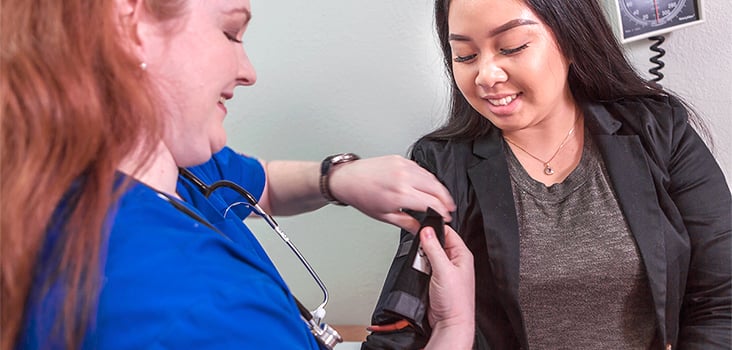
What Employers Need to Know about Occupational Health
Your employees are your greatest investment. When they get sick or injured on the job, getting them back to full health and function is a top priority. But it’s even better if you can prevent the illnesses and injuries in the first place. Keeping your employees healthy and safe is a key to maintaining a productive workforce. Attaining these goals can be a challenge for employers, but you don’t have to go through it alone.
Occupational health can help safeguard your employees from workplace risks using everything from injury prevention and pre-placement testing to work injury care and physical therapy.
Regardless of your company’s size or industry, an occupational health program can help reduce overall health care costs and improve employee productivity. There are several ways occupational health services can benefit your business.
Set the stage for success.
Improving an employee’s safety and well-being can begin before an offer letter is given. Your strategy should not only outline any specific workforce health and safety issues that plague your company, but should also have measures in place to combat them. A candidate can look great on paper, but a resume likely won’t confirm if he or she can safely perform a job. An occupational health clinician can work with you to develop a comprehensive plan to help you select candidates based on actual ability rather than potential. Occupational health professionals can recommend conducting pre-employment screenings to help ensure that potential hires are capable of safely performing their jobs. This helps empower employers who are looking to hire the right personnel and avoid unnecessary accidents.
There are many different types of pre-employment tests, but every kind of pre-employment test must be compliant with the Americans with Disabilities Act (ADA) and the Equal Employment Opportunity Commission (EEOC). Test components vary depending on what each job requires an employee to do. Pre-employment tests include pre-placement physicals, DOT physicals, and drug testing. Another common pre-employment test occupational health clinicians perform is a “human performance evaluation,” or HPE.
HPEs test an applicant’s ability to physically perform certain actions. They are used for both pre-employment and return-to-work testing. A HPE typically includes:
- A review of the employee’s medical and occupational history
- A medical exam
- An evaluation of functional tasks such as lifting, carrying, pushing, and pulling
Because occupational health clinicians only test for things that will keep the job applicant from safely performing their job, this type of screening is compliant with the American with Disabilities Act.
Drug testing is an important part of the hiring process and routine maintenance of owning a company for many reasons. It’s proven to be the best preventive measure in ensuring the safety of your workplace. Employee drug use increases the risk of an accident, therefore doing everything in your power to make sure it is not taking place within your workforce is crucial. Urine tests are the most common, but drug tests can also be completed using hair, nail clippings, blood, or saliva.
Be proactive, not reactive.
Injury prevention programs teach employees safe practices that can be applied at work and in their personal lives. These programs can help employees understand:
- The benefits of regular exercise and its role in keeping them healthy, fit, and energized
- Proper stretching methods and safe lifting techniques to avoid overexertion injuries
- How ergonomics can help reduce the risk of repetitive-motion injuries
If a work injury does occur, you want to ensure that your employees receive immediate and effective treatment from an experienced occupational health provider. The sooner an employee starts treatment after an injury, the sooner recovery can begin. This early intervention philosophy, combined with an active treatment plan that keeps the employee moving through the healing process, can yield a faster and fuller recovery. An injury prevention strategy puts employers in the driver’s seat, enabling them to take early action to avoid some costly OSHA recordable incidents.
Prevent illness by protecting health.
Keeping your employees safe and healthy also includes implementing preventive measures for illnesses. Health screenings, vaccinations, and medical surveillance exams can help protect employees from various health hazards that can impact an employee both at work and at home.
Participating in health screenings or preventive exams regularly can help employees recognize potential threats to their health and direct them toward a treatment plan or wellness program. Additionally, administering routine vaccinations and travel health immunizations can help prevent employees from contracting infectious diseases and viruses, whether they’re working locally or abroad.
If your employees are regularly exposed to hazards at work, such as toxic chemicals or extremes in temperature or noise, they are at a higher risk of developing acute health issues. Medical surveillance exams protect employees and employers by establishing quality control processes to directly reduce exposure to dangerous substances and conditions.
Occupational health keeps your company operating at peak performance.
Occupational health providers offer the services you need to maintain a safe and healthy workforce. Whether you’re looking for preventive services or treatment, occupational health is designed with your workplace in mind. Occupational health providers can also help you maintain compliance with occupational safety and health regulations and workers’ compensation guidelines.
As the largest occupational healthcare provider in the nation, Concentra® will partner with you to protect your greatest asset while saving you money. Ready to learn more? Let’s get started.



